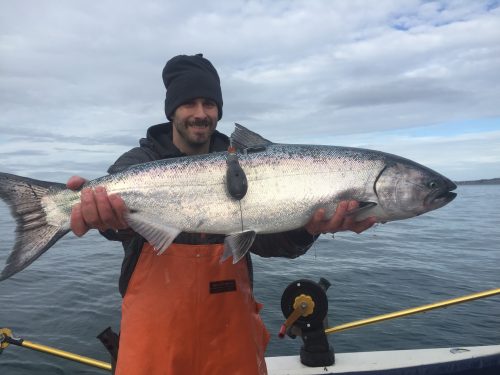Satellite tags reveal what's eating older chinook salmon
May 13, 2019
Lauren Frisch
907-474-5350
Sometimes being a scientist requires a bit of detective work.
Andy Seitz, a researcher at the University of Alaska Fairbanks College of Fisheries
and Ocean Sciences, needed his detective hat when an alarming number of his fish tags
started popping up to the surface of the ocean early.
“At first we speculated an equipment malfunction,” Seitz said.
Seitz and CFOS researcher Michael Courtney have been using pop-up satellite tags to
study chinook salmon since 2013. A satellite tag is attached to a fish, where it collects
data on temperature, depth and ambient light intensity. On a pre-programmed date,
the tag releases from the fish, pops up to the surface of the ocean and transmits
its stored data to satellites that researchers can access from a computer.

Seitz and Courtney were testing whether the tags are an effective tool for studying chinook salmon ecology and behavior. They focused on understudied late-stage marine salmon that have spent more than a couple of years at sea.
“It has been assumed that the early stage in the ocean is more dangerous,” Seitz said, “and that fish become safer as they grow.”
The Arctic-Yukon-Kuskokwim Sustainable Salmon Initiative and the Pollock Conservation Cooperative Research Center funded the project.
Early in this project, a number of the tags were transmitting data sooner than expected. Each tag is programmed with an “abort mission!” sensor that is triggered when the tag is inactive for three days, telling the tag to automatically transmit data to satellites even if it’s before the programmed release date.
Seitz and Courtney had tagged big chinook salmon off the coast of Dutch Harbor in December, when temperatures in the Bering Sea are about 4 to 6 degrees Celsius (about 39 to 43 degrees Fahrenheit). But in many of the prematurely transmitted datasets, the researchers noticed a sudden spike in temperatures days before the data was transmitted.
“The depth records of these tags were still moving up and down, sometimes down to 400 meters, and remaining at this 25-degree temperature,” Seitz said. “The only place that can happen is in the stomach of a warm-blooded salmon shark.”
After exiting a shark's digestive system, the tag would pop to the surface and remain inactive, triggering data transmission.
The researchers tagged 43 late-stage chinook salmon between 2013 and 2017, and 35 of the tags transmitted data back to satellites. Marine predators, including warm-blooded salmon sharks, cold-blooded fish and marine mammals, consumed 19 of the 35 tagged fish.
“These results do show that pop-up satellite tags are an effective tool for learning about chinook salmon ecology and behavior — and mortality, too,” Courtney said. “There aren’t any other research methods that allow you to continue to collect data after a fish has been consumed.”
These results also suggest that late-stage marine salmon may not be as safe as originally suspected.
This study was recently selected as an editor’s choice in the Canadian Journal of Fisheries and Aquatic Sciences because it provides new information on a previously understudied salmon life stage. Seitz and Courtney are working on proposals to continue their studies. With additional years of tagging, the team can consider how predation rates change annually and regionally, and what this means for chinook salmon populations.


